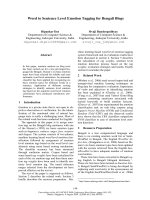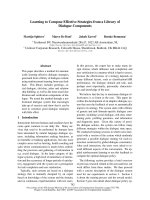Báo cáo khoa học: "Sampling to Detect Rare Diseases" pptx
Bạn đang xem bản rút gọn của tài liệu. Xem và tải ngay bản đầy đủ của tài liệu tại đây (30.06 KB, 1 trang )
Acta vet. scand. 2001, Suppl. 94, 93-93.
Acta vet. scand. Suppl. 94 - 2001
Sampling to Detect Rare Diseases
By Preben Willeberg
Danish Slaughterhouses, Axelborg, Axeltorv 3, DK-1609 Copenhagen V, Denmark.
Monitoring / surveillance and estimation / de-
tection of specific diseases are common proce-
dures used in national disease control in farmed
animals. When the disease is assumed to be rare
or even absent, such activities are especially im-
portant, e.g. in documenting a preferable zoo-
sanitary status as part of trade agreements. The
statistical and epidemiological aspects of de-
signing such investigations and the difficulties
in properly analysing and interpreting the data
are far from trivial. This presentation will point
to some of these problems and it will suggest
ways and means of minimising some of the dif-
ficulties.
Screening for disease to estimate its prevalence,
e.g. during the course of a control or eradication
program, must be based on a valid sampling
scheme. Examples of such will be given from
recent field studies.
Documenting freedom from disease must simi-
larly be based on sampling when the aim is to
document a continued freedom from a disease
never found in, or previously eradicated from,
the population. It is important to realise, how-
ever, that proving initial absolute freedom from
a new or exotic disease cannot be made from a
representative sample of the “normal” popula-
tion! Examples of the confusion created by not
recognising this distinction will be given.
Another common problem in designing and in-
terpreting farm animal disease sampling is the
frequently neglected effect of clustering by
herd and other units, which will be illustrated
and discussed.
The validity of the diagnostic procedures used
to characterise the individuals in the sample as
either positive or negative are of similar impor-
tance. Estimation and optimisation of the test
sensitivity and specificity are integral parts of
performing a survey or maintaining a surveil-
lance programme.
Various methods to improve test sensitivity and
specificity will be mentioned, and the impor-
tance of being able to estimate these character-
istics will be illustrated. Newer methods for
these purposes have been introduced in the
field, and these will be discussed.









